Stringing Together the History of Tennis
Dr. David Flakoll is a man with a vision and a passion for tennis, which extends to preserving the history of the game through the racquets that tell its story.
Flakoll took up tennis in 1976 shortly after going into practice as a clinical psychologist as a way to balance his behind the desk job with some outdoor exercise. His interest in the game as an enthusiastic player quickly turned professional when a few years later he focused his practice on sports psychology and started the Tennis Psychology Institute, running seminars for tennis players and other athletes. His professional study of the game and its athletes also led him down the collector’s path.
Flakoll started by taping televised tennis matches and collecting tennis videos which he could use in his work to study players and how they played the game. It was a visit to the home of a local tennis racquet stringer that inspired Flakoll to think bigger, not only about what he collected but how his collection could be displayed and used to tell a story of the history of tennis. “I remember walking into the room in his home where he strung his racquets and his walls were layered in tennis racquets. The display really interested me.” It also turned his sights on collecting wooden tennis racquets-his first a Chris Evert Autograph.
Flakoll formulated a ‘developmental model of collecting’ to build his collection, which continues to evolve and inform his collecting strategies. “The first phase was the Economy Stage – I began to go to thrift stores – over 80-and came away with over 1000 mainly wood racquets. In this manner, I was able to build a large collection at a relatively reasonable cost.”
Next came the History Stage: “I started to go to the International Tennis Hall of Fame in Newport, RI, and access their museum, go to tournaments … I had a press pass to interview the players and great legends of the game. Went every year from 1998 to 2015 and studied in the Hall of Fame Research Center to determine what was special, and I began to develop a collection around racquets of the Hall of Famers. [Access to the Library] was so helpful in understanding the racquet collection and what I should be looking for.”
“The fourth stage is what I call the eBay Stage. I joined eBay in 1999. Of the 6,500 racquets in my collection, I would say 5,000 came from eBay, from all over the world. I would collect not only racquets but other tennis memorabilia to display in these rooms in my house – books, journals, magazines, ball cans, photos, etc.-particularly to amplify the tennis racquet collection emerging in each of these rooms.”
Flakoll’s Fifth Stage is his networking phase-connecting with tennis writers, collectors, and makers of racquets from around the world. The Sixth Stage is buying at higher-end auctions. “I have not yet done a lot of that.”
In addition to building a collection for Grand Slam and Hall of Famer rooms, Flakoll is interested in collecting racquets from American makers and brands. “I have 601 to date and that’s a major part of my collection, especially in the US Open Room.” When asked what’s on his wishlist, Flakoll says he is looking to complete this collection with an example from every US maker and brand.
“There are so many collections within each collection that are meaningful. Newport-branded racquets, racquets after colleges and universities, and the English racquets are some examples. These are also other realms of collecting. The books on tennis collecting, the primary ones, have been so helpful in my own collection that has guided the vision of my collecting. They’ve been very inspirational for me.”
“It reflects the creativity and ingenuity of inventors who have brought creative (and odd) innovations to the game of tennis, and how the great legends of the game have continuously sought out these innovative racquets. There may be some [collections that are] more valuable because of a focus on higher end racquets, but none have the span of tennis history and depth and significance of my collection.”
His most prized possession? “The Hazel Streamline racquet-I have a collection of 15 of those. Triple branch racquets (instead of just a single handle, there are three branches). The racquet emerged in 1935. Bunny Austin was known for using these racquets at Wimbledon.”
Always a man with a vision and a plan, Flakoll has ideas for what happens to his collection next, including establishing a tennis museum near where he lives in Northern California. Although Flakoll sees a brick and mortar museum as one option, he acknowledges that the more economical route would be a high-end display on the Internet where his collection can be better represented visually than it can be viewed now on photobucket.com (Alamocrest). Another interesting possibility he shares is having someone else, perhaps another collector or a museum, take over the collection.
What’s in his future? “I have in mind to write a book on the history of the tennis racquet and American-brand racquets.” He needs only to look to his walls and halls for inspiration!


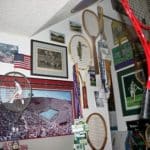
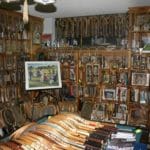
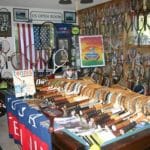
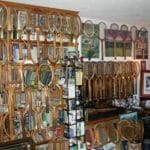

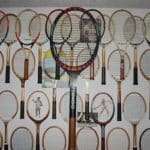





Related posts: